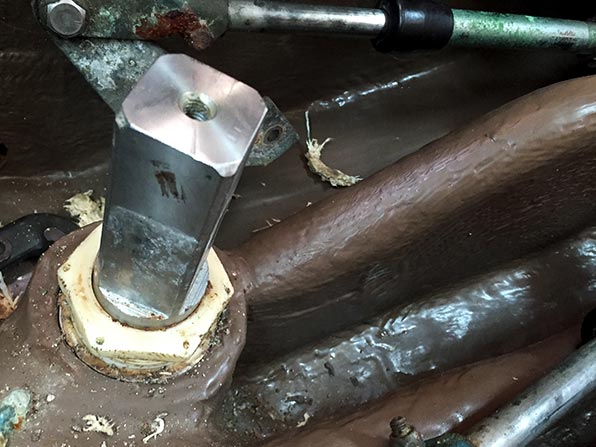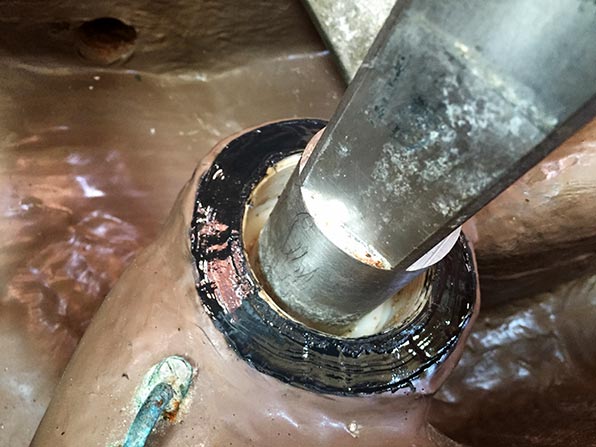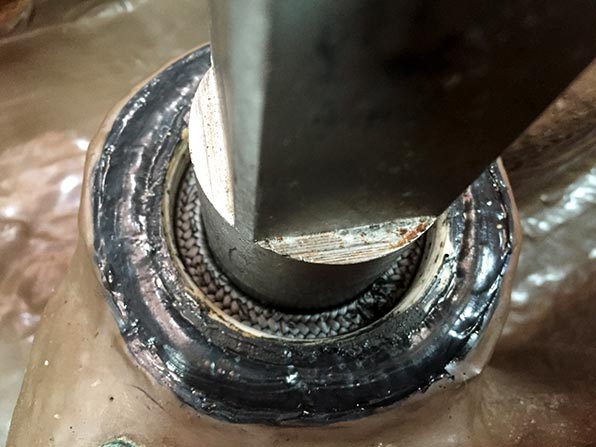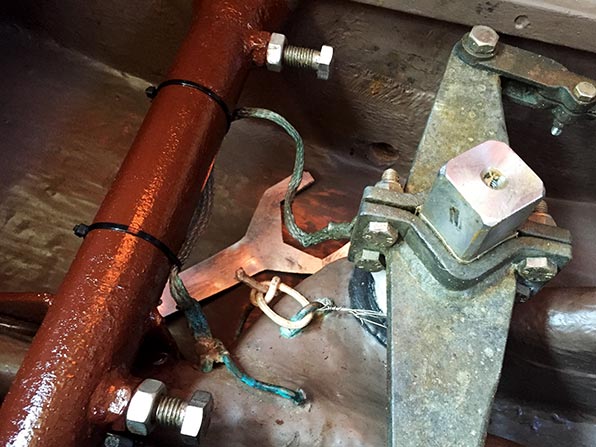Rudder stuffing box repair
Here is the post that many of you have been waiting for, the one that describes the repair to our rudder’s stuffing box. To begin, the video below shows the problem.
Ignore the small electrical terminal visible at times in the bottom left of the video. It has nothing to do with this and was just sitting there, having fallen down from above.
The outer sleeve that is in contact with the hull is not supposed to be rotating! While sailing, water would make its way into the boat through the space between the hull and the sleeve.

The first thing to be done is to remove the quadrant, etc. from the rudder post. Here you can see Curtis and Afzal from Dynamite Marine getting to work.

With the cables and quadrant removed, the boys attempted to remove the entire sleeve from the boat using a large puller. Unfortunately, the nylon nut was damaged in the process, requiring a new one to be fabricated.

Without removing the sleeve from the boat, a long shot without dropping the rudder, we moved on to Plan B. Here you can see the packing material removed from the stuffing box. According to the boys, it was not installed well. Instead of several complete rings of packing material, one on top of the other, there were various smaller pieces making up the layers. This is not how it should be.

Another view of the same stage.

This diagram that I just made up illustrates what was done to stop the rotation. Four holes were drilled, each half into the hull and half into the sleeve. We were happy to see that the residue from the holes was completely dry. After cleaning away all of the dust, the holes were filled with epoxy, first thinned to fill any gaps, and then following that, thickened for strength. The epoxy was left to set overnight. The following day, with no other steps taken, the outer sleeve remained fixed when the rudder was rotated, exactly as planned.

Following that, a channel was cut around the circumference of the sleeve approximately 10mm deep. After cleaning, the channel was coated with a thin layer of epoxy and then filled with 5200 (virtually permanent adhesive). This was then left to sit for an entire week for it to fully cure.

This image shows the new packing material, properly cut, inserted into the stuffing box.

And here you can see the entire thing reassembled. Several nuts and bolts were replaced, and the entire assembly was cleaned and coated with lubricant and anti-corrosion material. Stainless steel seizing wire was reinstalled to prevent the nut from loosening (note that the wire was missing in the above video). The brown pipe which acts as a stop for the quadrant was also cleaned and repainted.

This last image shows the wrench (spanner) that the Dynamite guys fabricated to more easily adjust the packing nut. It is tied there with a short piece of line so that it is always available.
I am happy to say that since the repair, not a single drop of water has made its way into the boat from this area, exactly as it should be!
Below is the ★★★★★ review I submitted to Active Captain for Dynamite Marine, the guys who did all of our repairs in Trinidad.
“Although not our first trip to Trinidad, this was our first trip to the island to have boat work done. Recommended by Peake’s Yacht Services, I contacted Dynamite before traveling to see if they could help with our issues. Graham, who answered my messages, said come on down.
When we pulled into Peake’s travel lift bay, Graham from Dynamite was there to greet us. Before we even hauled he came on board, and I discussed the main issue that I needed to have addressed (our rudder’s stuffing box had separated from the boat), as well as a number of other jobs that we wanted to have worked on. Over the course of the next week to ten days, the boys from Dynamite looked after everything that I threw at them.
For much of our stay in Trinidad, we were not living aboard. When we arrived to the yard each morning though, the boys were often already on site, working away.
When launch day came and it was time to splash, we had four of the guys from Dynamite on hand to make sure that all of the jobs that they completed were done properly, and that we were good to go. Even after we splashed, when I found that I had new, unrelated issues that I needed help with, they made themselves available. That included just this morning when Graham came on board and crawled into a locker to deal with a plumbing issue that I was having. This, he did without charge!
The guys from Dynamite get our recommendation, without question.”



Great job. I have one concern:
It would appear that you are using graphite-impregnated packing (e.g. Duramax, Graphtex, etc.). I have more than a little familiarity with this, because I have no choice but to use it on my propeller shaft packing (long story, not relevant here, which I will share with you if you want to hear it).
You need to be aware that stainless steel (and including many shaft alloys such as Aquamet) is anodic to graphite. So there is a potential for galvanic corrosion of the shaft when using this type of packing.
You should seriously consider changing to conventional waxed packing, whether flax or PTFE, for your rudder stuffing box. FWIW.
Hmmmm
Thanks, Sean. After doing some research, we have decided to change it when we haul again in January.
Reply from Dynamite:
Mike.
As promised, I caught up with the guy I most respect for information on shafts, props and seals. I spoke with him about your concerns and he whole heartedly agreed with Sean and advise that you change out the Graphite packing for either Flax or PTFE.
As you know that was the only one in the correct size I could get when we did the job and can only apologize, however I know you have to haul again to do the bottom, and as everything has been cleaned, freed up and greased it should be a very small job for somebody to replace.
I have never been one to believe I know everything and have nothing to learn, I also don’t have a problem with admitting I’m wrong, in this instance you got Graphite cos thats what we could get, not because I wanted to use it but in future I will be making customers wait whilst I get non Graphite. I’m sorry you were the Guinea pig and will make it up to you when we next meet, please don’t let this put you off Trinidad or Dynamite Marine.
Fair Winds and a Happy Life.
Graham
Looks like an extraordinary job by the Dynamite team (I am trying to refrain from saying it was a dynamite job … ooops!).
This is just one example of how systems can get a bit “out of standard” over time and/or in the face of needing an expedient solution.
I think they did a great job too.
Great write up, thanks for all the details and pictures.
Normally on a stuffing box there is a jam nut to keep the adjustment from moving on you. Similar to Sean above, my experience is more with prop shafts, so maybe this is different. On a prop shaft the packing is water cooled and you adjust it so that you are getting a periodic drip while underway, but none while not moving.
I wonder if the original cause of the issue was due to the pieced together packing material. If they had to really tighted the nut to get it to stop leaking, it probably could have locked the rudder shaft to the sleave. You have plenty of torque available when turning the steering wheel, and the connection between the hull and the sleeve was the weakest link.
Well done!
Hard to say what the original cause was. Over tightening the nut definitely could have been at least part of it.
Hope this plays where you are.Watch “Kid Dy-no-mite!!!” on YouTube
https://youtu.be/v19PpD5uqL0
I used to watch that show.
Looks like a solid fix! The was one thing i would have re-considered, the epoxy filler in the drilled holes might have been plugged with a stainless or aluminum pin (think tooling pin) as a more solid/complete locking system. Either way i feel your problem is solved.
That certainly would have been an option.
I am assuming that boats are like aircraft and that there is constant vibrations running thru the hull. So while attaching the spanner to the spot that it is used sounds good, I would be leery to leave it there.
Could it move around enough due to vibrations to eventually wear it’s way thru the brown coating on the inside of the hull? Vibration and loose objects will do amazing things.
I’m not too concerned about it but I’ll keep my eye on it. Thanks.
Thanks for your perseverance and the fine write up with photos Mike. Your work educates us all. Fair winds Captain.
Thank you, Sir!
Mike,
With regard to the comment about the graphite, the corrosion, etc.
I have no idea about the corrosion.
However, the packing Amel sells is perfectly white. I know this because another owner showed me his spare packing Amel sold him years ago (white) and Amel sold me some a year ago (white).
Cheerio,
We will be changing the packing material when we haul again in January.
And you felt this repair could not have been done in Grenada, yes?
In some fashion, I’m sure it could have. The yards were unable to accommodate us on the timeline that I wanted though.